Delamination cell
The delamination measuring cell is another proprietary development. With lid, base and heatable double-walled glass cylinder, this measuring cell is suitable preferably for multi-layer coated sheet. Focus of the analysis is mostly the deeper coating layers when the outer cover layer is damaged, for example by falling rocks.
There is still another version of the delamination measurement cell. It has only a cover for insertion of the electrodes while the bottom is fixed with silicone on the sample. This type of cell is used when, due to the roughness of the coating, an O-ring as a seal can not be used. Fields of application are often the tests to cathodic disbondment (cathodic disbonding, CD).
Delamination cell
|
The delamination measuring cell is another proprietary development. With lid, base and heatable double-walled glass cylinder, this measuring cell is suitable preferably for multi-layer coated sheet. Focus of the analysis is mostly the deeper coating layers when the outer cover layer is damaged, for example by falling rocks.
|
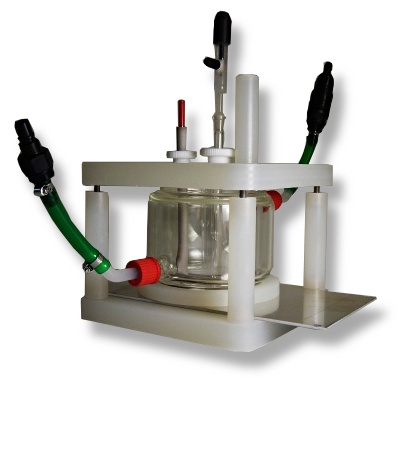 |
|
There is still another version of the delamination measurement cell. It has only a cover for insertion of the electrodes while the bottom is fixed with silicone on the sample. This type of cell is used when, due to the roughness of the coating, an O-ring as a seal can not be used. Fields of application are often the tests to cathodic disbondment (cathodic disbonding, CD).
|
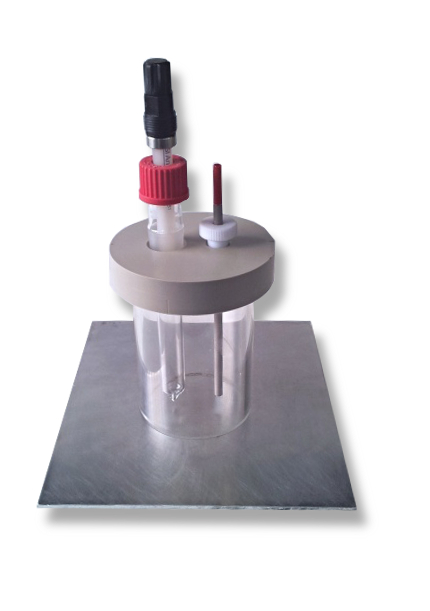 |
Devanathan cell
|
The proprietary Devanathan cell represents an appropriate instrument for measuring the hydrogen permeation through a (steel) plate.
The Devanathan cell consists of two measuring cells, which are connected via a semi-permeable wall or membrane. Substituting this membrane sample by a metal (e.g. steel), the permeation of hydrogen, which is generated on one side of a sample (in first measuring cell), can be measured in the second cell.
|
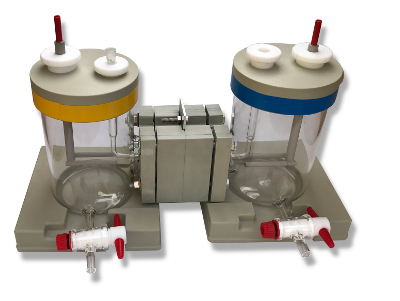 |
|
In this figure we show a load sample instead of a membrane to induce hydrogen during a load experiment (constant load or slow strain rate).
|
|
|
As corrosion measuring cells we provide the types KMZ 3and KMZ 5. Both measuring cells are three electrodes measuring cells for potentiostatic measurements of research the corrosion behaviour of metallic materials.
The measuring cell KMZ 5 could be thermostated by use of a double-walled glas container. Thereby a complete measurement setup is available for those measurements even at higher temperatures. The measuring cell mounting plate with standard taper joints (NS) for the pick-up of working and counter electrode as well as intermediate vessel with reference electrode and liquid junction tube including a Haber Luggin capillary. The measuring cells feature practice-orientated handling for a wide range of application.
|
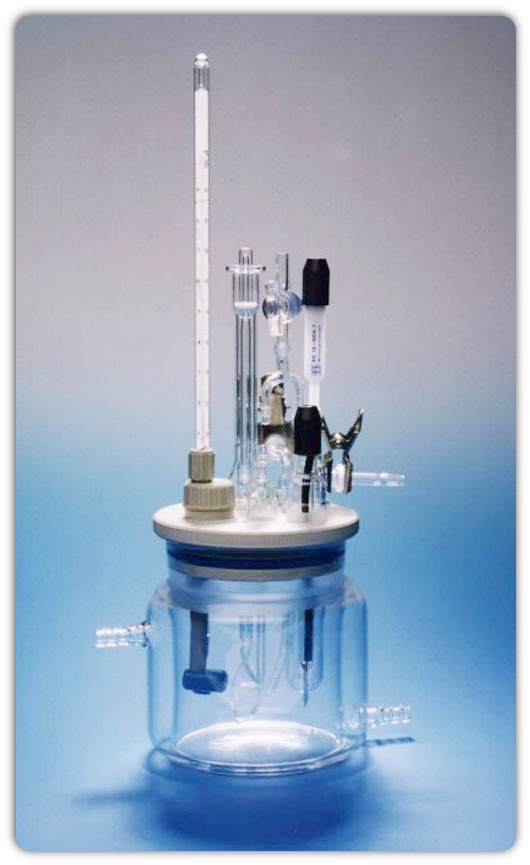 |
Technical specifications:
| Cell vessel |
Glass; max. 130 x 130mm
KMZ 5: double-walled with hose connection
|
| Capacity |
max. 500ml |
| Mounting plate |
ca. 120mm |
| Working / operating temperature |
KMZ 3: max. 50°C (122°F)
KMZ 5: max. 110°C (230°F)
|
| Sample mount / holder |
PP; NS-29 |
| Counter electrode |
NS-24; Platinum sheet 4cm² |
| Gas inlet and discharge |
Glass tube; NS-14,5 |
| Reference electrode |
KE10 / NSK 7 (Calomel, 60°C [140°F] )
SE10 / NSK 7 (Ag / AgCl)
|
| Current key with Haber-Luggin-Capillary |
two-part; NS-19 / NS-7 |
| Intermediate vessel |
Glass part; NS 29 |
| Material |
KMZ 3: PVC, PP, Glass
KMZ 5: PP, Glass
|
Product contents:
Measuring cell KMZ 3 or KMZ 5 complete with:
Sample mount / holder (WE), counter electrode, reference electrode (Calomel), current key, intermediate vessel, gas inlet and discharge.
(Optionally available: Reference electrode (Ag / AgCl), KPG agitator)
The pictured thermometer above is not included in the product contents!
IPS FlatCell
|
The IPS FlatCell is a self-development and it is used for studies of flat samples, which will be flange-mounted sideways. In difference to the other cells of this kind, which are available, our cell is equipped with a double walled glass jar, so it is heatable. The first customer measured temperature-dependent the impedance of coated samples with a plausible and reproducible solution.
The cell is constructed robust. The counter- electrode consists of platinum-plated titanium, is provided with a 4mm hole for standard banana plugs and it is screwed in plastic. The bonding takes place in an easy put in of a banana plug.
|
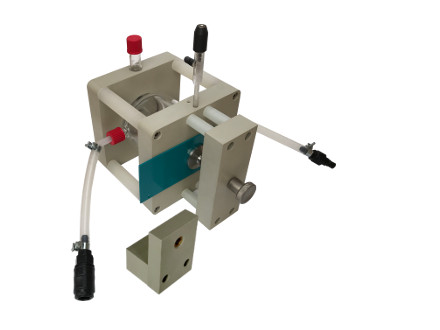 |
|
At the front the sample sheet will be inserted between the screw connections and clamped with a screw. The screw passes through a piece of brass, which is fixed to the screw connections. If larger panels are used, a U-plate can be set below and the upper screws can be sunk. Then a lager plate can be inserted from the top. The locating screw for the sample is also provided with a 4mm hole, so a simple banana plug suffices for bonding.
The reference electrode is inserted into the top of the plastic plate, the tip ends immediately in front of the sample panel. Thereby in the glass are no feedthroughs. Just both of the glass screw connections for thermostatization are in the outer sheath of the glass jar.
|
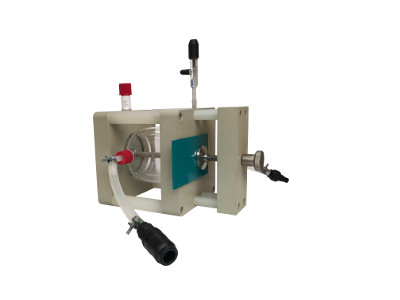 |
ZRA-FlatCell
|
ZRA-FlatCell is a modified IPS FlatCell. The basic idea is, to use this cell for measurement of short circuit current between two samples.
At both sides a working electrode can be tapped and then connected with a ZRA for measuring of short circuit current. Of course this order can be used for the measurement of electrochemical noise.
|
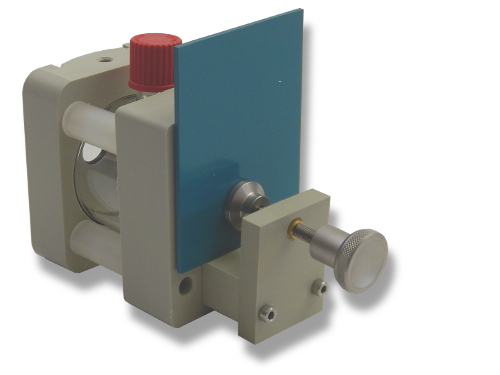 |
|
It is also possible to flange at the one side a counter electrode and at the other side a working electrode. The filler hole can be used for dipping a reference electrode. With that this cell would be a normal, not heatable FlatCell.
|
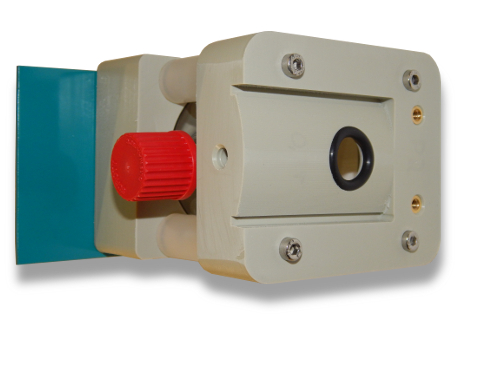 |
Reference electrodes
As standard reference electrodes we offer two glass electrodes in a short and a long construction with a NS7 grinding in variants of Kalomel, Ag/AgCl, Hg/HgSO4 andHg/HgKOH. Those electrodes are equipped with a 4mm banana jack and fit into the intermediate vessel of KMZ3/5.
Furthermore we have let manufactured own intermediate vessels for our cell containers for rotating electrode, which subserve as salt bridge and capillary and also are suitable for the aforementioned reference electrodes.
Additionally we have used them in cells and constructions, where they were immerged immediately into the electrolyte. The ceramic diaphragm at the top of the electrolyte offers a good protection, even in direct contact with the electrolyte. If you want to measure without chloride, the use of an intermediate vessel and an Hg/HgSO4 electrode is recommendable.
Besides those electrodes we offer a hydrogen electrode of the type of Hydroflex.
|
Hydroflex is not larger than a pen, it works without an inner fluent electrolyte and it is successively applicable in many solutions.
With 12 cm length it is just as big as a pen and thereby easy to handle. The shaft has a diameter of ca. 8 mm. The head of HydroFlex consists of resistant plastic (PMMA) and the shaft is made out of PTFE. You can apply the PTFE-shaft in solutions until a temperature of 210°C. The ambient temperature for the head should not exceed 50°C.
HydroFlex is applicable in a lot of solutions one after the other. If the use for example in Hg/HgO-references in acid or in Ag/AgCl in lyes is forbidden, HydroFlex for example can be took out of sulphuric acid and used in another solution for example potash.
It works without an inner, fluent electrolyte and without an additional electrolyte bridge. The entry of undesirable ions isn’t possible anymore.
By an internal hydrogen supply, no extra hydrogen bottle is needed. The hydrogen supply works with a changeable Cartridge.
For a direct insertion in battery cells we have let manufactured a special intermediate vessel with a small top.
|

|
Counter electrodes
As a counter electrode we supply as standard to KMZ3//5 a vitreous body with NS 24, a platinum sheet with 24 cm² and a 4mm banana jack. For measuring cells for our rotating electrodes we supply a round vitreous body with a 2mm banana jack and a round platinum sheet with 2cm diameter, which will be contacted with a 70mm long platinum wire.
This wire gives the system a higher flexibility. With skillful bending the sheet metal can be placed at the bottom of the measuring cell under the rotating electrode. In special cases we have delivered the standard electrode with this wire extension.
In special applications for example for simple cells for the measurement of cathodic disbonding we delivered counter electrodes made of platinum plated titanium in rod shape.
The active length of this electrode amounts 150 mm, the diameter 6 mm, in principle those dimensions are optional.
For special glass jars with an individual height we have extended this part, embedded it in plastic and assembled it with a standard grinded plug, so the part can be inserted in the lid.
For rotating cylinder electrodes or rotating disc electrodes, for which a higher current is necessary, we have delivered electrodes, which you can see on the following pictures.
Intermediate vessels
We have already delivered intermediate vessels in different designs. The following picture shows a standard intermediate vessel for the measuring cell for our rotating electrode. The head has a NS7 for the standard reference electrode, the glass body has an outer diameter of 12 mm and the diaphragm on the top points upwards. For rotating cylinder electrodes we also have inserted it laterally, so the top can be positioned in front of the electrode.

Either the intermediate vessel is inserted with a drilled ground glass joint stopper or with a pressed fitting in the lid. Thereby the intermediate vessel can be moved in height, which allows exact positioning.
The following picture shows a similar intermediate vessel, but with a NS14.5 for standard lids. It also can be used in KMZ3/5 and provides a simplified opportunity to bring the reference electrodes.

The next picture shows an intermediate vessel, which was especially made for Hydroflex reference electrode. The measurement should be performed in between the lamellae of a car battery. Via the narrow tip of this intermediate vessel the measuring point can be well positioned.
